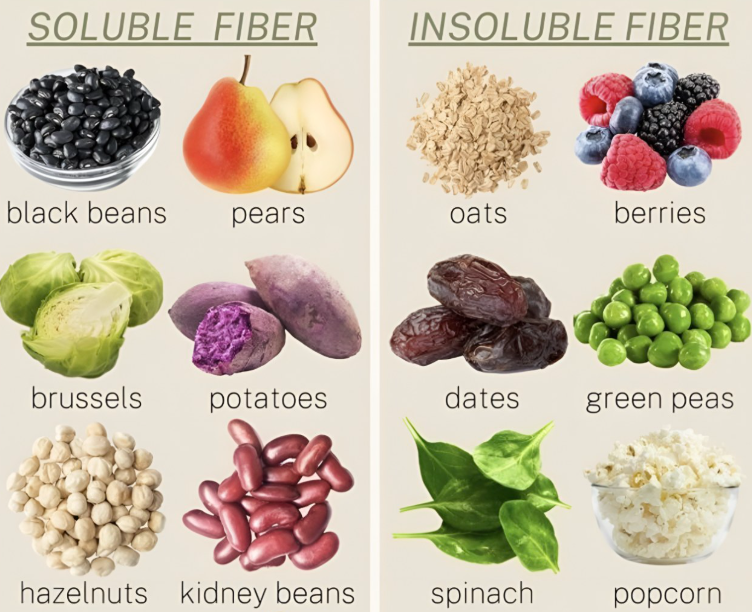Fiber is an essential part of a healthy diet, playing a crucial role in digestion, heart health, and overall well-being. It comes in two main forms: soluble fiber and insoluble fiber. While both are beneficial, they serve different functions in the body. Let’s explore their differences, benefits, and food sources.
What is Soluble Fiber?
Soluble fiber dissolves in water to form a gel-like substance, which helps slow digestion and improve nutrient absorption. It is particularly beneficial for heart health and blood sugar regulation.
Health Benefits of Soluble Fiber:
- Helps lower cholesterol levels by binding to bile acids.
- Slows the absorption of sugar, aiding in blood sugar control.
- Promotes a healthy gut microbiome by serving as food for beneficial bacteria.
Food Sources of Soluble Fiber:
- Black beans – A great source of plant-based protein and fiber.
- Pears – Rich in fiber and antioxidants, supporting digestive health.
- Brussels sprouts – High in fiber and essential vitamins.
- Potatoes – Especially beneficial with the skin on, providing fiber and nutrients.
- Hazelnuts – A good source of healthy fats and fiber.
- Kidney beans – Packed with fiber, protein, and essential nutrients.
What is Insoluble Fiber?
Insoluble fiber does not dissolve in water. Instead, it adds bulk to the stool and helps food move through the digestive system more efficiently, preventing constipation and promoting regular bowel movements.
Health Benefits of Insoluble Fiber:
- Aids in digestion by increasing stool bulk and preventing constipation.
- Helps maintain a healthy gut by speeding up waste movement.
- May reduce the risk of certain digestive disorders, such as diverticulosis.
Food Sources of Insoluble Fiber:
- Oats – A great source of fiber that supports digestive health.
- Berries – Packed with fiber, vitamins, and antioxidants.
- Dates – High in fiber and natural sugars for a quick energy boost.
- Green peas – A nutritious vegetable rich in fiber and protein.
- Spinach – A leafy green loaded with fiber, vitamins, and minerals.
- Popcorn – A low-calorie, high-fiber snack that supports digestive health.
How to Incorporate More Fiber into Your Diet
To reap the full benefits of fiber, it’s best to include a mix of both soluble and insoluble fiber in your daily meals. Here are some tips:
- Start your day with a fiber-rich breakfast, such as oatmeal topped with berries.
- Snack on nuts, seeds, and popcorn instead of processed foods.
- Add more vegetables like Brussels sprouts and spinach to your meals.
- Eat whole fruits like pears instead of drinking fruit juice.
- Incorporate legumes like black beans and kidney beans into soups and salads.
What we learned from this article?

Both soluble and insoluble fiber play vital roles in maintaining overall health. While soluble fiber supports heart health and blood sugar control, insoluble fiber ensures smooth digestion and regular bowel movements. By including a variety of fiber-rich foods in your diet, you can promote better digestive health, improve metabolism, and enhance overall well-being.
